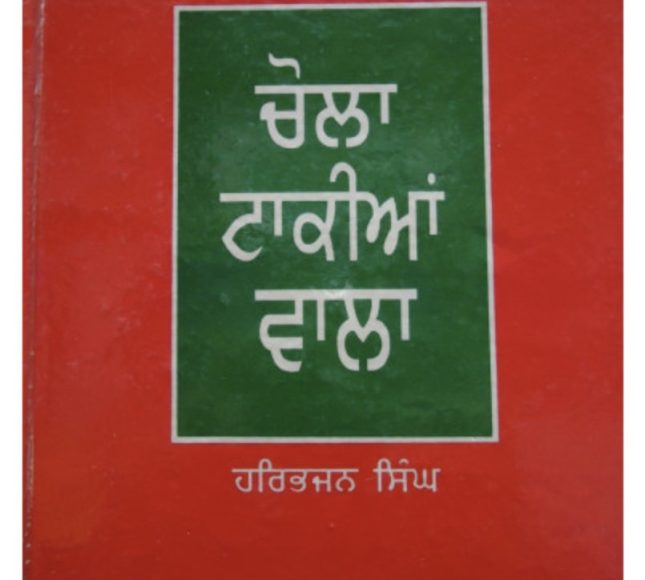Chola Takian Wala (A Garb with Patches) is an autobiography of Dr. Harbhajan Singh Professor Emeritus and an eminent literature of Punjabi. This autobiography consists of 30 chapters of varying lengths. The title of this piece is a symbolic one. The author has defined his life through a symbol of a garb which has patches. A hidden connotation of spirituality is detectable in this metaphorical expression. Dr. Singh has revealed the very secret of his success in life and has narrated artistically, a few significant episodes directly related to his academic and literary career. In his childhood, the untimely death of his father and then of his mother, made him lonely and isolated.
As a young boy, he led a life of economic hardship and struggles. At this critical juncture of his life, he began writing verses. He attained self-actualisation and contentment by dedicating his life to literature. His poetry is full of satire and inner-irony. He tells us how he has expressed his rebellion without using hard words of aggression; how he has depicted his inner crisis, conflicts and convictions of life in his various literary writings; how he has emerged as a poet of modem Sensibility how he has been influenced and inspired by the works of his contemporary counterparts, etc. To him literature is stylised society and the style itself is a deviation from the norms.
References :
1. Harbhajan Singh, Chola Takian Wala (A Garb with Patches), Navyug Publishers, Delhi, 1994.
Let’s journey into Chola Takian Wala: A Symbolic Autobiography by Dr. Harbhajan Singh—a narrative that is as much a memoir as it is a testament to resilience, creativity, and the transformative power of literature.
The Symbolism Behind the Garb with Patches
The title itself, Chola Takian Wala, meaning “a garb with patches,” is a potent metaphor for a life marked by imperfections, struggles, and subsequent repairs. In this autobiography, Dr. Harbhajan Singh chooses to define his existence through an image of a fragmented yet resilient garment. Each patch represents a significant episode—moments of loss, hardship, artistic growth, and ultimately, selfactualization. This metaphor highlights the beauty inherent in imperfection and the idea that our life’s narrative is enriched by the challenges we overcome.
Early Struggles and the Spark of Creativity
Dr. Harbhajan Singh’s story begins with deep personal loss—the untimely death of his father, soon followed by the passing of his mother. These early experiences of isolation and economic hardship could have easily led to a life of despair. Instead, they became the crucible in which his creative spirit was forged. In the wake of his loneliness, he discovered solace in writing verses, setting him on a path that would eventually define his literary legacy. This period of his life is depicted not just as a time of suffering, but as the fertile ground from which his distinctive poetic voice arose—a voice full of subtle satire, inner irony, and reflective depth.
Crafting a Literary Legacy Through SelfExpression
Throughout the 30 chapters of this autobiography, Dr. Singh reveals the secret of his success in life: the power of literature as a personal and societal revolution. His writings are not aggressive outbursts but measured expressions of rebellion—an artful defiance against societal constraints and norms. His journey is one of continual evolution, where each chapter in his life is akin to a patch mended onto a wellworn cloak. Through his creative process, he has managed to articulate the inner crisis, conflicts, and convictions that many of us experience, yet render them with the nuanced elegance of a poet of modern sensibility.
Reflections on a Life Dedicated to Literature
In narrating his story, Dr. Harbhajan Singh does more than recount personal anecdotes—he offers insights into the broader landscape of Punjabi literature and the transformative role of creative expression. His reflections underscore the idea that literature is a stylized society, one that not only mirrors cultural values but also challenges them. By embracing his own imperfections and transforming them into a source of creative power, he has left an indelible mark on the literary world. His tale is inspirational for anyone seeking to find beauty and meaning within the fractures of life, and it continues to influence and inspire contemporary writers and thinkers alike.
Dr. Harbhajan Singh’s Chola Takian Wala is a celebration of the human spirit—resilient, everevolving, and impervious in its quest for selfexpression. What resonates with you most about this reflective journey? Is it the transformative symbolism of life’s patches, the emergence of creativity from adversity, or the nuanced portrayal of literature as both a personal refuge and a powerful societal force? Perhaps you’d also be interested in exploring how these themes compare with autobiographies from different cultural contexts or in discussing the enduring impact of literary resilience as a testament to creative spirit.



